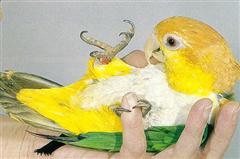Caique - White bellied
Caique - White Bellied
Sat, 12th July, 2025 - 7:55 am GMT
Sponsor Ads:

Alternative Name
Caique - White BelliedBasic Info
Growing to about nine inches in length, White-bellied Caiques have predominantly green plumage. They are extremely colorful little birds with orange upper ear coverts, crowns, napes and foreheads. Their bill is horn colored, and the periopthalmic ring is white. White-bellied Caiques have flesh-colored feet. The iris is red. White-bellied Caiques have yellow throats and cheeks. Their undersides are a creamy white color, and their under-tail covers are yellow in color. White-bellied Caiques' primaries and primary coverts are a deep violet or purple-blue color, and the upper sides of their tails have green feathers. The underside of the tail is a gray-black color.
Health
White-bellied Caiques do very well on a basic pellet food supplemented with lots of fresh fruits and vegetables along with grain and sprouted seeds. They love to play and bathe, and need an ample supply of leafy green branches for chewing. If they are kept in a cage, they will need lots of exercise and playtime- getting a playpen is suggested! Be sure your bird has many toys and perches in his cage to keep him amused; a Cockatiel cage is the right size, but the larger, the better. White-bellied Caiques need lots of your time and love. Breeding In the wild, White-bellied Caiques raise clutches of two to four eggs after a gestation period of about 27 days. The female does the sitting while the male procures food. The chicks leave the nest at 12 to 14 weeks of age. Captive breeding of White-bellied Caiques has been very successful. They breed January through June in nesting boxes. Their eggs are removed from the nesting boxes by humans and incubated at 99.9 degrees Fahrenheit and 50 percent humidity. They hatch in 26 days and should be removed to a 97-degree room with humidity to saturation, until they acquire feathers. For their first five to seven days of life, White-bellied Caique chicks are fed every 90 minutes on commercial formula especially for psittacines. At one week of age, they are fed when their crops are empty, about once every two and a half hours. After they are four and a half weeks of age, the chicks should be fed four times daily and by the time they are eight weeks of age, weaning can begin. At 12 to 14 weeks, the chicks are fully weaned and an adult diet along with soft carbohydrates, like soaked bread or pasta, are offered. Immature White-bellied Caiques have black feathers scattered atop their heads. The base of the bill is blackish, the feet are dark gray, and the iris is also quite dark.Habitat
Resides in tropical lowland forestsBehavior
If you have plenty of time and energy to devote to a pet, the White-bellied Caique may be right for you! These playful little birds are among the most beautiful of the parrot family and if you can devote enough of your time to a Caique, you will be well rewarded. In the wild, White-bellied Caiques spend most of their time up in the tree tops and love to play with twigs and with fellow flock members! Some times pairs will travel separately from the flock. They eat fruits, berries and seeds. White-bellied Caiques nest very high in the canopy. Captive-bred White-bellied Caiques seem to have an endless energy supply and enthusiastic personalities! They love to play and bathe, and need an ample supply of leafy green branches for chewing. White-bellied Caiques are extremely sociable even though their talking ability is quite limited. If they are kept in a cage, they will need lots of exercise and playtime- getting a playpen is suggested! Be sure your bird has many toys and perches in his cage to keep him amused; a Cockatiel cage is the right size, but the larger, the better. When raised correctly and handled firmly, White-bellied Caiques are fun friends! They are very intelligent and can learn a variety of tricks!Origin
BrazilHistory
White-bellied Caiques are native to Bolivia, Brazil, and Peru, where it resides in tropical lowland forests. First recorded by Kuhl in 1820, obscured White-bellied Caiques have recently gained an almost overnight popularity in aviculture. This is wonderful, because as their habitat is destroyed, captive-bred birds may be the only hope for the reintroduction of Caiques to the wild and the preservation of the species.Common Foods
White-bellied Caiques do very well on a basic pellet food supplemented with lots of fresh fruits and vegetables along with grain and sprouted seeds.Sponsor Ads:
- Ours is less and less a free society. -- Lawrence Lessig
Caique - White bellied
Coded by: BGID® | ALL RIGHTS RESERVED Copyright © 2000-2025
Disclaimer | Privacy | Report Errors / Contact | Credits








 Preparing For China. China is growing their military. China Military Technology - can it keep up with the US?
Preparing For China. China is growing their military. China Military Technology - can it keep up with the US?  versus
versus 

 versus
versus 
 This Thread is about the North Korean Military itself - the kind of army, navy, and air force they have.
This Thread is about the North Korean Military itself - the kind of army, navy, and air force they have. 
 versus
versus 
 versus
versus  versus
versus